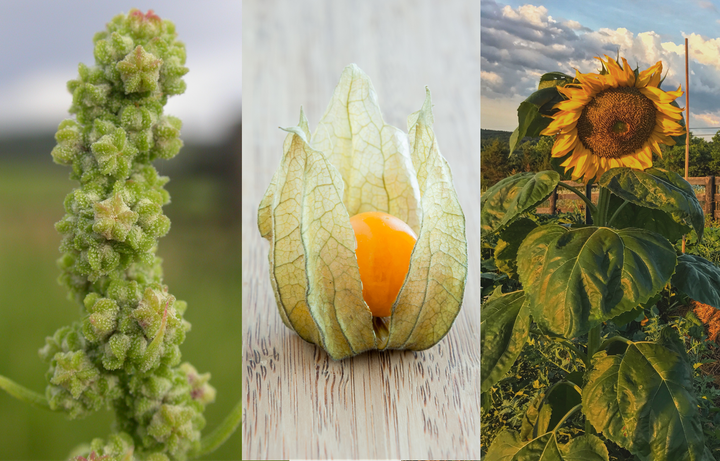

The Cherokee Chefs Bringing Back North America’s Lost Cuisine
Researching traditional foods led them to the revelations of an archaeological dig in Kentucky.
In March, a few weeks before COVID-19 shut down the country, chef Nico Albert and her longtime mentee, chef Taelor Barton, met at Duet Restaurant + Jazz to discuss plans for their upcoming Native American dinners and culinary classes.
Each November for the past two years, Albert has turned the menu at Duet Restaurant + Jazz into full Native American fare. While the seasonal, New American food that Albert serves year round has made the 140-seat eatery one of Tulsa’s most beloved fine-dineries, it is this menu of contemporary Native dishes, available only during Native American Heritage Month, that truly stands out. Locals and regulars flock to the restaurant, and Cherokee and other tribal members come from as far away as Michigan or Seattle. The offerings—which include persimmon frybread pie made with Pawnee heirloom corn and crispy, sumac-crusted snapper with roasted squash, wild greens, sweet corn hazelnut sauce, and pickled blueberries—routinely sell out.
The women, both members of the Cherokee Nation of Oklahoma, were slated to lead historical-foraging and Spring Onion Dinner experiences about pre-colonial foodways and matriarchal roles, and cook suppers of traditional Cherokee foods for local museums and historical societies.
They were also discussing possibilities for this year’s November menu at Duet. (Barton may be a guest chef.) Of course, it should continue to feature contemporary Native American food, whose presence at a fine-dining restaurant remains rare and special. But might it also debut their effort to restore one of North America’s oldest regional indigenous cuisines—one that has been almost completely lost, and is rarely referenced outside the pages of archaeology journals?
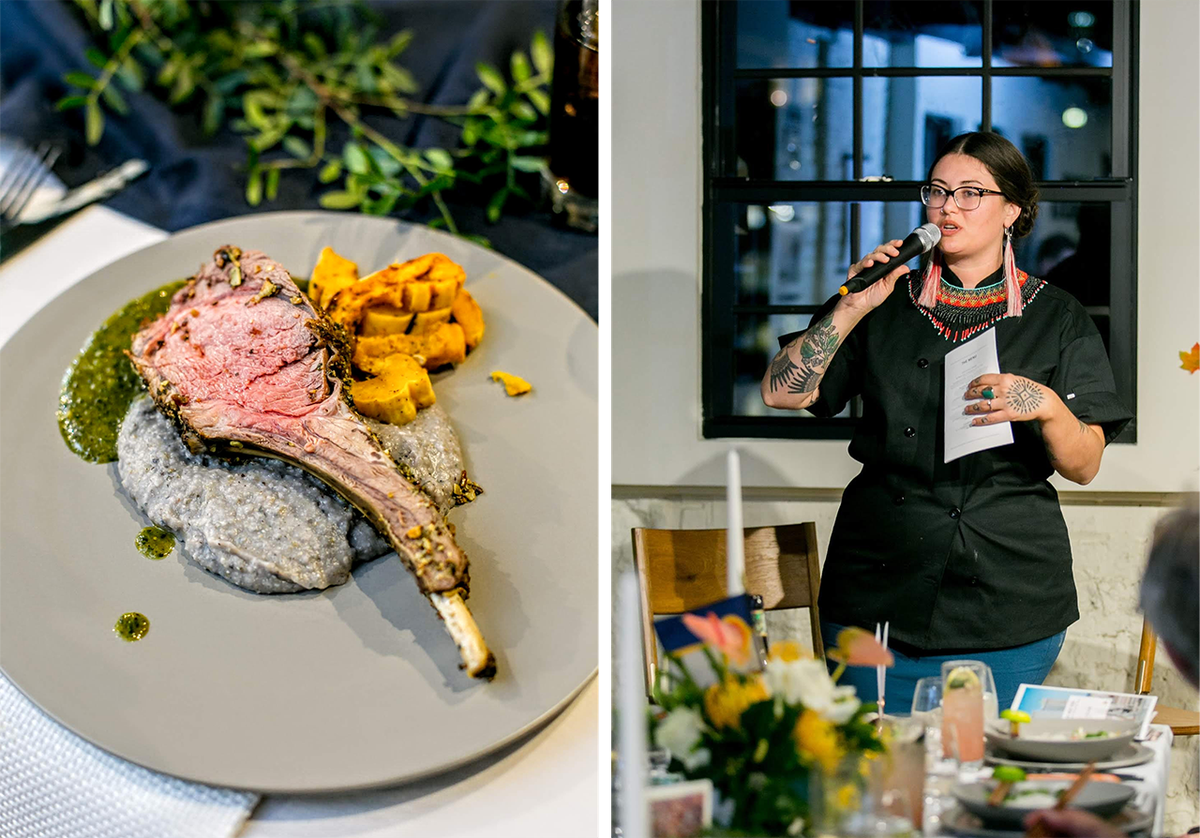
Barton suggests doing at least one entrée—perhaps rabbit legs seasoned with dried sassafras leaves and braised with cedar fronds in wild sunflower oil, served over a bed of quinoa-esque pitseed goosefoot grains and the plant’s sautéed leaves (reminiscent of kale) and okra-like milkweed seed pods.
If that happens, it will be the first time such tastes have been publicly available in at least 1,000 years, and one more step toward their shared goal of launching a restaurant to showcase it and other historic Native foods.
Barton and Albert stumbled upon the ancient cuisine essentially by accident. The two met in 2011 at an event on the future of traditional Native American foods. Albert gave a talk arguing for a chef-led revitalization that would educate eaters, foster cultural awareness, and preserve foodways through use. An industry of tribal farmers, foragers, caterers, and restaurateurs could, for example, grow, sell, and serve dishes with wild rice, a cherished Native ingredient long grown along the Great Lakes but displaced by boaters and home owners who see it as a weed.
Barton, then a student at the Oklahoma State University School of Culinary Arts, was impressed.

“That was a turning point,” she says. The truth hit her hard: Undermined by displacement and centuries of cultural assimilation, indigenous foodways were careening toward extinction. The hope, which motivates a number of increasingly prominent Native chefs, was that creating a nation of diners interested in Native American food would provide resources to maintain them.
“We’ve inherited this rich, beautiful history centered in a deep respect for nature and the sustenance it provides,” says Albert, echoing the punchline from her 2011 talk. “Our traditional foodways are the embodiment of that relationship. To lose them is to lose the essence of our cultural identity.”
The women became friends, and Albert soon hired Barton to cook under her at the first of various Tulsa restaurants. They researched historic Native foodways, visited tribal elders to document culinary traditions, explored obscure cookbooks (such as 1951’s Cherokee Cooklore), and used what they learned to craft contemporized dishes.
By 2015, the two were putting on Native dinners for local non-profits, museums, and educational organizations. Regional chefs such as Brad Dry joined the effort, and Sean Sherman—who won a James Beard Foundation Leadership Award in 2019 for his efforts to revitalize and boost awareness around indigenous food systems in a modern culinary context— encouraged them to join national discussions around defining Native American cuisine.
Attending events like 2018’s Native American Cuisine Symposium and the 2019 National Native Food Sovereignty Summit brought separate but mutual epiphanies: Albert and Barton realized most modern Native cuisines, including their own, are pastiche-like. Without formal precedents or pre-colonial records, chefs have to rely on clues from early European descriptions, old cookbooks, and extant tribal foodways from around North America.
“On one hand, that’s led to a fantastically creative culture of interpretation and cross-pollination,” says Albert. On the other, menus often pair foods from radically different cultures—like, say, Floridian Seminoles and Southwestern Navajos.

There was also a problem of mixing historical eras. Chefs like Sherman focused on decolonizing their cuisines by using only ingredients present in the Americas before 1492. Others featured adaptions stemming from colonial influences, displacement, and cultural assimilation. Like echoes of a lost heritage, the latter pointed to a land-based ethos of foraging, gardening, and seasonal ingredients. But the picture was murky at best.
Citing the success of hyper-regional modern cuisines, Albert and Barton wanted to do something more Cherokee-specific. They began to focus on pre-European foodways from traditional Cherokee lands in the central and southeastern Appalachian Mountains, and surrounding areas—territory where the Cherokee lived until they were forcibly relocated by the U.S. government over the Trail of Tears in the mid 1800s.
The chefs’ historical reconstruction began with scholarly books and papers, then calls and emails with historians, archaeologists, and paleoethnobotanists. They learned about iterations of Three Sisters farming methods, which had proliferated throughout what is now the eastern United States by about 1300. They discovered reclaimed varieties of indigenous heirloom corn, beans, squash, watermelon, and pumpkins.
Still, they wondered, what came before?
The question led Barton to scholars like David Morgan and Kristen Gremillion, and obscure discoveries in places like Kentucky’s Red River Gorge, a 29,000-acre canyon system in the Daniel Boone National Forest.
Before the Gorge finds, archaeologists “assumed that the peoples of this region just sat around passively, waiting for others to send them the gift of agriculture,” says Morgan, director of the National Park Service’s Southeast Archaeological Center. “But that simply wasn’t the case.”

Plant materials recovered by archaeologists in the Gorge in the 1980s and ‘90s led to a historical revision “that fundamentally alters how we think about indigenous peoples of the [precontact eastern U.S.],” says Morgan. A trove of ancient seeds debunked then-dominant theories “depicting early inhabitants as backwater nomads that didn’t acquire agriculture—and thus the markers of complex society—until after A.D. 1, when maize arrived from Mesoamerica.”
Gremillion, a paleoethnobotanist, chairs the Ohio State University department of anthropology and is the author of Ancestral Appetites: Foods in Prehistory. She started working in the Gorge around 1989, using techniques such as direct radiocarbon dating and high-magnification microscopy to study ancient caches of seeds, food stores, cooking refuse, and human feces. She found specimens buried under massive stone outcroppings and in caves—all in remarkable condition.
“We found things like 3,000-year-old sunflower heads and baskets full of seeds,” says Gremillion, who compares the digs to opening storage vaults. The finds were unprecedented, and old vanguard archaeologists were dismissive. “They said the materials couldn’t possibly be so old.”
Gremillion’s research proved them wrong; the region’s indigenous peoples had been farming for more than 5,000 years. The work helped establish the Eastern Woodlands as an independent center of prehistoric plant domestication and agricultural development—alongside areas like southeast Asia, Mexico, and the Fertile Crescent.
“The importance of these finds cannot be overestimated,” says Morgan. They pointed to stable residential patterns, ideas about land ownership, and developed economies. To tribes that lived in semi-permanent villages within defined territories and grew canny agricultural complexes of crops.
Of particular interest to Barton was the nature of those crops. All were native to southeastern North America and had been refined for culinary purposes. The majority—along with the cuisine they underpinned—had been lost to history. Today, most are considered weeds.
“These gardens were radically different from those described by early Europeans,” says Gremillion. So too, the foods that came from them.
Barton wasn’t just learning about a few forgotten ingredients—she was rediscovering an entire food culture. When ancient Greeks and people around the Mediterranean were pressing olives into olive oil, tribes in the Eastern Woodlands were cultivating sunflowers and marsh elder to make cooking oil. Like rice farmers in ancient China, the ancestors of the Cherokee grew amaranth, maygrass, erect knotweed, and barley for pseudo-cereals and grains. Hog peanut and other bean-like fruits played a role similar to soybeans. Sugar was unknown in the Americas, so sweet tastes came from a slew of berries and fruits, including American black nightshade, savory ground cherries, and other interesting oddities. (Or at least they seem odd today.)
While squash, sunflowers, and berries remained staples, other crops were replaced by foods like corn, beans, and tomatoes from South and Central America. Archaeologists speculate they were abandoned because harvesting the tiny seeds and grains was tedious and labor-intensive. But that doesn’t mean the older foods weren’t tasty. Basically, says Gremillion, the new foods were easier to grow and brought better yields, which is why they eventually dominated agriculture throughout parts of Europe, Africa, and Asia, replacing longtime local staples.
Barton recognized the lost foods’ culinary potential immediately: It was as if, in a world without olive oil, where the only olive trees were wild ones, she was the only chef learning about the ingredients used a millennium ago around the Mediterranean. She shared her research with Albert, who found it equally exciting. Combined with other Eastern Woodlands traditions—like nose-to-tail butchery techniques, meats from wild game, unique approaches to fermented foods, and the use of rare varieties of heirloom vegetables, fruits, and spices—the crops could lay the foundations for an unprecedented historic cuisine.
Barton says fully relaunching the cuisine will take time. As with other rare native foods, “the biggest problem you face with something like this is sourcing [ingredients].”
For instance, while pitseed goosefoot—sometimes called lambsquarters, or pigweed—produces broccoli-like flowers and quinoa-esque seeds, you won’t find it at farmers’ markets. “You’re having to track down the seeds, establish demand, convince farmers to grow these plants that haven’t been grown for food in centuries—and all of that’s going on at more-or-less the same time,” says Barton.
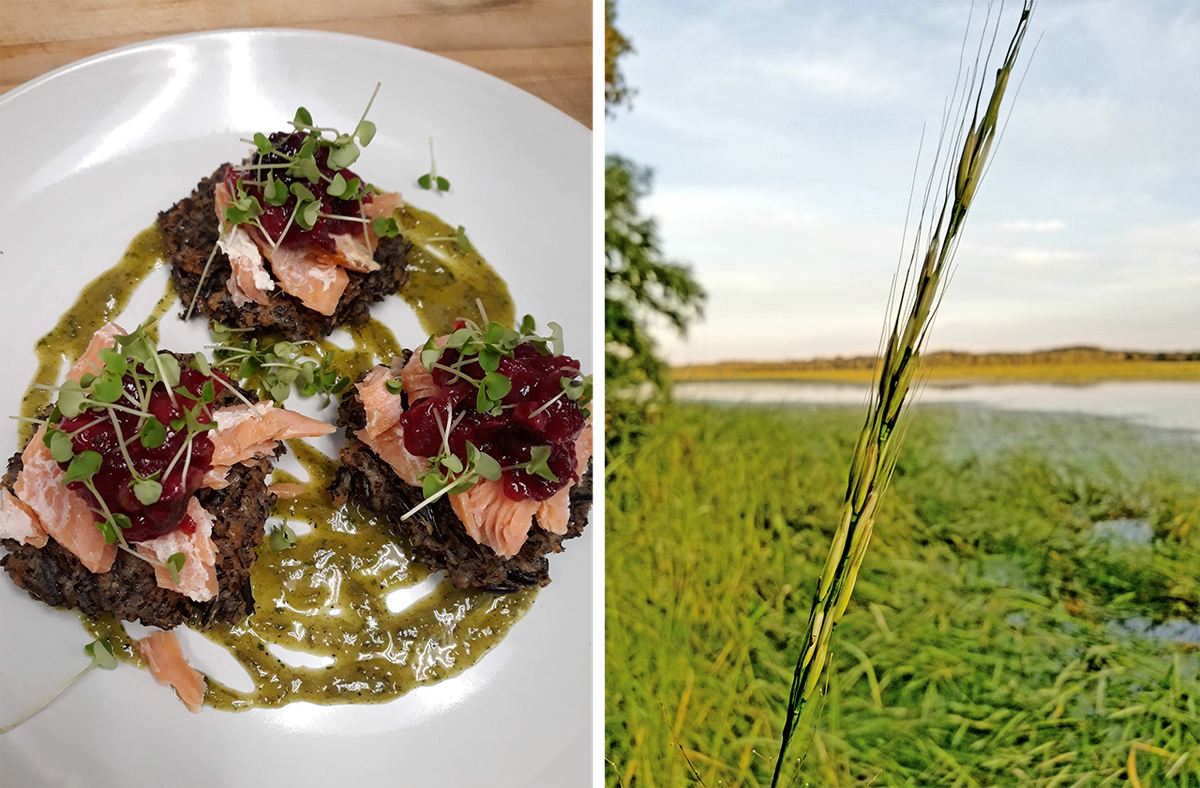
To make it happen, Albert and Barton are developing partnerships with local Native American farmers and chefs, and organizations such as the Cherokee Nation Seed Bank, Pawnee Seed Preservation Project, and Sean Sherman’s North American Traditional Indigenous Food Systems program. Barton is talking with the Eastern Band of Cherokee Indians about founding a specialty farming collective. The work is continuing through the pandemic, and the chefs are confident it will eventually yield a restaurant.
“The response to Native American items on the menu at Duet has been incredible,” says Albert. “Most people have never seen or experienced anything like this. And it’s really encouraging, because, once they’ve had a taste, they typically want more.”
Albert and Barton plan to use events like Duet’s Native American Heritage Month dinners to prime the waters for, and continue telling the story of, their ancestral Eastern Woodlands cuisine.
“Native dishes always come with a story,” says Albert. At Duet, she trains servers to teach patrons about ingredients and traditional uses. For instance, an appetizer of smoked trout and manoomin fritters (made with indigenous wild rice) topped with cranberry relish and finished with a drizzle of charred scallion vinaigrette is prefaced by an explanation.
“Manoomin, which literally translates to ‘good berry or grain,’ is the word Anishinaabe people of the Great Lakes region use for wild rice,” says Albert. The long, dark brown to black pseudo-grain has been used for upward of 12,000 years. It’s sourced from tribal agricultural cooperative Red Lake Nation Foods.
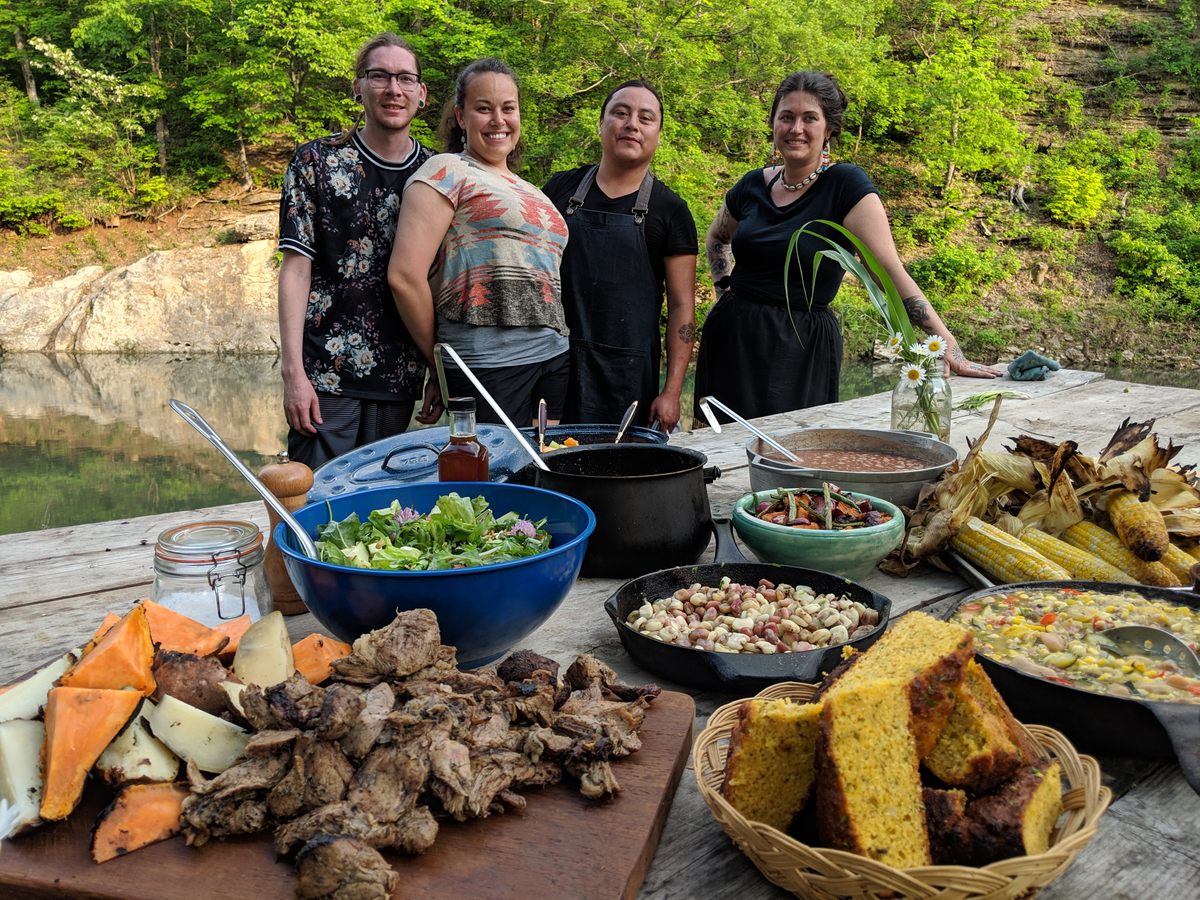
Barton hopes to partner with Albert to expand the approach at an Eastern Woodlands-themed restaurant. She envisions prix fixe meals that are both educational and reminiscent of a small ceremony.
“On one hand, it’s about recalling the symbiotic relationship we once had with the land, plants, and animals that sustain us,” and trying to replicate that in the context of a modern restaurant, says Barton. On the other, “we want to teach people about these incredible traditions and foodways.”
The meals will help tell the story of one of North America’s oldest regional cuisines—and transport eaters deep into the past, to 1492 and beyond. As Cherokee, the women say such meals offer a way to celebrate, affirm, and change perceptions around the ingenuity of their ancestors.
Gastro Obscura covers the world’s most wondrous food and drink.
Sign up for our email, delivered twice a week.





























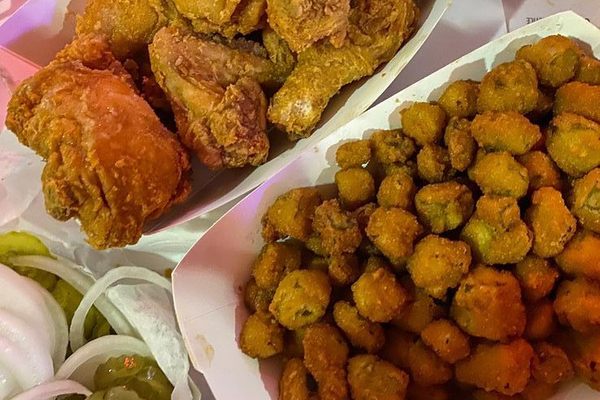






Follow us on Twitter to get the latest on the world's hidden wonders.
Like us on Facebook to get the latest on the world's hidden wonders.
Follow us on Twitter Like us on Facebook